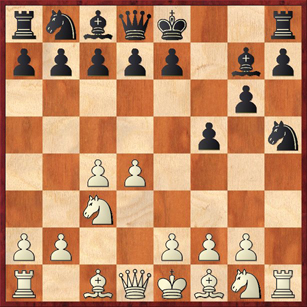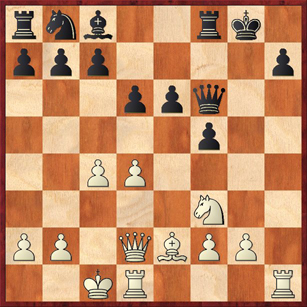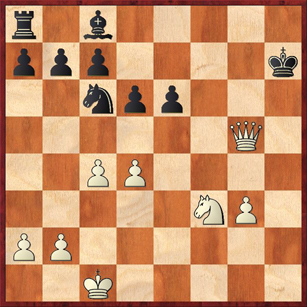The Berkeley International 2008 reached the halfway point yesterday, and it’s still a wide-open race for first place. As one might have guessed, Izoria and Kacheishvili played a quick draw (only 11 moves). Three other players have joined them in a five-way tie at the top: Daniel Rensch, Dashzegve Sharavdorj, and Irina Krush. Rensch drew with Josh Friedel; Sharavdorj beat yesterday’s hero, David Pruess; and Krush annihilated Marc Esserman.
Once again Pruess had probably the most exciting game, but this time his strategy of playing the sharpest possible openings apparently backfired on him. Sharavdorj (playing White) checkmated him on about move 33 of a Botvinnik Semi-Slav Variation.
I’ve already showed you two of Pruess’s games, so today I’m going to annotate the game by Krush that allowed her to move into a tie with the leaders. Although it’s a pretty one-sided affair, I enjoyed working out the various possibilities. After nearly losing to Iryna Zenyuk in round 1, Krush is quietly putting together a very good tournament. If she can draw or beat Izoria today, I would nominate her as my new dark-horse candidate to win. (But I still think the most likely outcome is a tie between Izoria and Kacheishvili.)
Irina Krush — Marc Esserman
Dutch Defense
1. d4 f5 2. c4 Nf6 3. Nc3 g6 4. h4 Bg7 5. h5! …
Irina gets such a good game out of this pawn sacrifice that I have to wonder whether this variation (3. … g6 and 4. … Bg7) is even playable for Black. Can someone who plays the Dutch (e.g., Michael “fpawn” Aigner) enlighten me?
5. … Nxh5
Ironically, I saw Michael playing this position (at least, I think it was this position)Â as White in the last round of the Thanksgiving Festival at Milpitas. It was ironic in two ways. First, Michael was playing against his own student, Brian Wai; and second, he was playing against the Dutch Defense rather than playing it himself.
Michael played 6. Rxh5?!, which seems as if it may be a bit too optimistic. After 6. … gh 7. e4 O-O the computer says that White does not have enough compensation for the exchange. I don’t remember what Brian Wai did exactly, but I know he didn’t castle, because when I looked at the game a few moves later his king was taking a walk in the center of the board.
I think the move order that Irina plays is more precise, because it retains the option of sacrificing the exchange next move, and it does not allow Black to castle.
6. e4! Nf6
Esserman does not want to give her another chance to take on h5.
7. ef …
Again, I don’t know any theory here, but 7. e5 also looks like a good option for White. But Irina’s move is well motivated; she is taking the opportunity to loosen up Black’s kingside. Black doesn’t want to castle kingside, but as the game shows, he may not have any choice in the matter.
7. … gf 8. Bg5 e6 9. Qd2 Qe7 10. O-O-O d6
Irina’s next move shows that Black’s king has tarried too long in the center. But what else was Black supposed to do? If 10. … O-O 11. Bd3 Qf7 12. Nf3 d6 13. Rdg1 threatening g4 looks pretty good for White.
Position after 10. … d6
11. Nd5! …
Exchanging off the defender of Black’s kingside, the knight on f6, before Black has a chance to defend it with his other knight.
11. … Qf7
The computer actually says that Black’s best move here is 11. … ed, after which the forced line is 12. Re1 Ne4 13. Bxe7 Nxd2 14. Bf6+ (well, this isn’t forced, but it’s sensible) 14. … Kf7 15. Bxg7 Kxg7 16. Kxd2. The only good thing about this line for Black is that he has gotten the queens off the board and so he won’t get checkmated. But otherwise, the position is just going to be excruciating torture for him. White’s rooks control all the key lines, the e-file and h-file and soon perhaps the seventh rank too. If this is Black’s best move, he might as well admit that the opening has been a failure.
12. Nxf6+ Bxf6 13. Be2 O-O 14. Bxf6! …
Again, capturing on f6 before Black gets a chance to bring his queen knight into the defense. Also notice that this puts Black’s queen and rook into a nice forkable configuration. This is what I call “moving your opponent’s pieces.”â„¢
14. … Qxf6 15. Nf3 …
I just can’t find any way to make this position playable for Black. The move I would really like to play is 15. … Nd7, because the kingside so desperately needs another defender. But unfortunately, 16. Ng5! is a powerful response. (16. Rh6 Qg7! is not so good: the e-pawn is poisoned because 17. Rxe6? Nf6 18. Re3 Ng4 displaces White’s rook and gives Black a fine game. And if 17. R1h1 Nf6, now Black has a chance to put up some serious resistance.)
After 15. … Nd7 16. Ng5! h6 (otherwise Black just loses material) 17. Nxe6!! Qxe6 18. Rxh6 Black’s position is indefensible. On either 18. … Rf6 or 18. … Nf6, 19. Qg5+ is too strong. Or if 18. … Qe7 19. Rg6+ Kf7 20. Bh5 Rh8 21. Rg5+ Kf6 22. Rxf5+!! would be a cute finale.
Or if 15. … Rf7 16. Rh6 Qe7 17. Ng5 Rg7 18. f4, Black is again unable to bring his QN to the aid of the kingside, because after … Nd7 the e6 pawn would hang.
All in all, I couldn’t find anything better than what Esserman played. But on principle, queen moves and rook moves in this position should not be sufficient to defend. White’s pieces simply outnumber Black’s pieces on the kingside. As long as Black is moving only his rook and his queen, he is not actually changing the balance of forces. That’s why a move like 15. … Nd7 had to be tried, but unfortunately it just doesn’t work.
15. … Qg7 16. Rh3 Rf6 17. Rdh1 f4
A clever move, whose purpose is to cut off the penetration of White’s queen into the kingside. It also threatens 18. … e5, which would finally make the QB into a relevant piece. However, Krush finds a way to nip that threat in the bud.
18. g4! …
The exclamation point is for the logic of this move. It stops the threat, and threatens g4-g5. Black cannot prevent this with 18. … h6 because White plays 19. g5! anyway. After 19. … hg 20. Nxg5! the knight on g5 is taboo because of the rook checks on h8 and then h7. Black could politely say “No thank you,” with 20. … e5, but then White would say “Please, I insist,” with 21. Rh7.
It was somewhat disappointing, when I plugged the game into the computer, to find out that the computer considers 18. Rxh7 Qxh7 19. Rxh7 Kxh7 to be better. The reason is 20. Qa5!, which both threatens c7 and threatens to bring the queen to the kingside with 20. Qh5+, after which Black can scarcely survive long. So Black’s move 17. … f4 didn’t really keep the queen out after all.
This move 20. Qa5 strikes me as being very much a “computer move” — the queen goes way over to the queenside in order to get to the kingside, somewhat like Columbus sailing west to get east. This is not the sort of move humans are able to find on a regular basis. So I consider Irina’s plan with 18. g4 to be much more instructive. It is an exemplary case of bulding an attack — bringing a new piece to the party every move, chipping away relentlessly at the opponent’s strong points, opening lines until the king is mercilessly exposed.
Esserman replied:
18. … fg 19. Rxg3 Rg6 20. Bd3 21. fg Nc6
Finally, and much, much too late, trying to activate the sleeping pieces on the queenside.
22. Rxh7 Qf6
The most thematic line would have been 22. … Qxh7 23. Bxh7+ Kxh7 24. Qg5 (diagram).
Position after 24. Qg5 (analysis).
This would be the culmination of White’s strategy — every last defender of Black’s king has been eliminated, and the king is now naked. 25. Qf6 is coming next, followed by Ng5+ and mate on h7 or f7, and Black can stop it only by giving up a lot of material. This position illustrates an important chess principle: it’s not the total amount of material on the board that matters, but the imbalance of forces in the venue where the battle is taking place. Black’s rook, knight, and bishop are almost irrelevant. The battle is taking place on the kingside, where White has a queen and a knight against nothing.
23. Rh6 resigns
A very impressive performance by Irina Krush.
In response to my last post, chesstiger said, “Wish I could play like that.” Going over all these games from the Berkeley International, that’s very much the way I feel, too. The more carefully I study them, the more I admire every one of these players. They are solving such difficult problems with so little time, playing with such clarity when for me there is only confusion. Going over the game carefully at home, I can gradually work my way through the confusion and see what Irina Krush was seeing. But to do it over the board, to find great moves, move after move, with the clock ticking? It takes poise, it takes discipline, it takes endurance, it takes confidence in yourself — all traits in which I am lacking at one time or another when I sit at a chessboard. I am inspired by those whom I see ahead of me on the path to mastery, but at the same time discouraged by how far ahead of me they are.
Round six update:
Because I took so long on this entry, round six is now complete (at least the top boards). Krush and Izoria drew; Kacheishvili defeated Sharavdorj; and Milman defeated Rensch. So after six rounds, Kacheishvili is in clear first with 4.5/6. Krush and Izoria are tied for second and third with 4/6. Interestingly, all of the top three have now played each other, so they will all be paired down next round. That could create some exciting action, as they will need to play for a win to be assured of keeping up with their competitors.








{ 3 trackbacks }